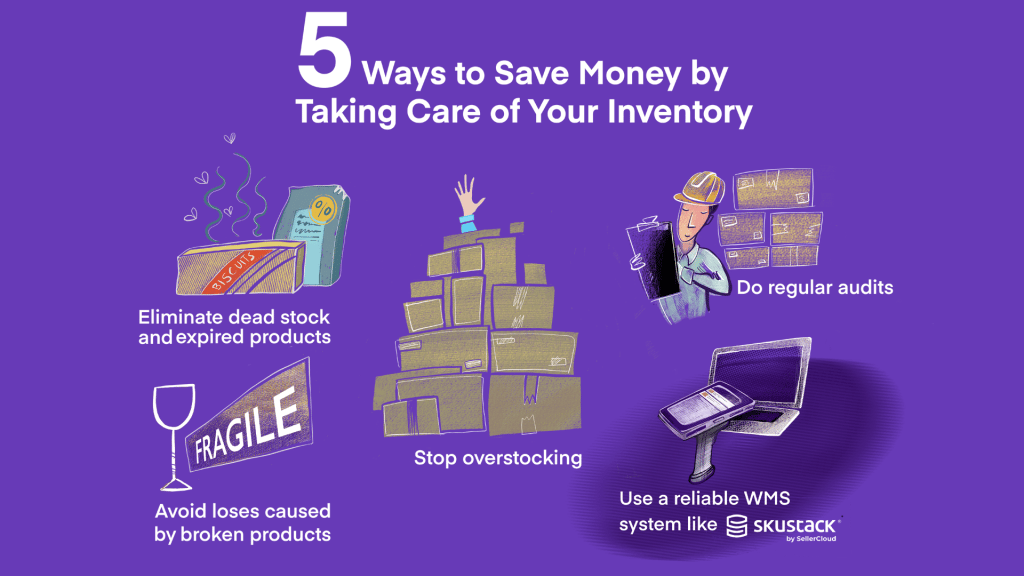
Being successful in an ecommerce business means simultaneously monitoring a variety of listings, marketplaces, inventories, and fulfillment workflows. Adding to the challenge is that selling online is a constantly evolving experience. As a result, the more agile and strategic you are in your decision-making, the greater your potential for success.
Making routine, purposeful adjustments across your entire business can result in huge savings, which, in turn, can mean larger profits. One area that is particularly ripe for optimization is how you handle your inventory. Poor inventory management can wind up costing you big.
In contrast, making smart moves about warehousing, carrying costs, record keeping, and real-time inventory tracking can reduce your overall Cost Of Goods Sold (COGS) and increase your profit margins.
Here are five of our favorite recommendations for saving money by being smart about your inventory:
1. Eliminate Dead Stock and Expired Products
Carrying costs on inventory that can’t or won’t sell is pure waste. Whether it’s damaged merchandise, returned products, out-of-date stock, expired goods, or items that simply aren’t selling (regardless of how many times you reprice them), paying to store this inventory in your warehouse costs you money.
The first challenge is recognizing that this dead stock exists in the first place. Regular inventory audits can help prevent these unsellable products from hiding in the cobwebs (more on this later).
The second challenge is locating and removing the offending merchandise. If you use multiple and off-site warehousing locations (like with FBA or a 3PL provider), you may not have easy access to hunt for these space-wasters. It is up to you whether it is worth paying to have this inventory located and returned to you or if you’re better off giving the go-ahead to destroy it.
Amazon has specific protocols for issuing a remove inventory order, as do most marketplaces and 3PL providers. When entrusting your warehousing to third parties, know the inventory procedures and how to initiate them.
2. Avoid Losses Caused by Damaged Products
If your ecommerce business sells fragile merchandise, it is important to make warehousing and shipping decisions that account for these unique types of products.
You need to be sure the entire fulfillment process, from warehouse to customer, includes the required degree of handling care to get your products to their destinations safely and in one piece. Although this may incur additional costs, maintaining overall customer satisfaction should ultimately be prioritized, particularly for third-party marketplace sellers.
Sure, shipping insurance can help offset the financial ramifications of damaged goods, but it also burdens customers to document and report issues. Customers expect their orders to arrive in perfect condition; they aren’t expecting to receive broken products and then have to spend their time filing claims (or waiting for a replacement to ship).

3. Stop Storing More than Necessary
Just as carrying costs on unsellable merchandise drive up your COGS, so does carrying too much merchandise. Bulk purchasing and production can seem like cost-effective business decisions, but often, sellers overlook the cost of storing these large quantities of inventory.
Optimizing the inventory quantities you are holding according to your typical rate of sell-through can prevent unnecessary storage and warehousing fees.
In addition, proper automated inventory reporting (like the cycle counting features offered by the Skustack WMS) can help ensure that you are set to reorder new merchandise at precisely the right moment to keep your listings live and avoid ‘out of stock’ messages—or worse, oversold merchandise.
Another option is to make the transition from third-party sales to first-party drop-shipping. This arrangement allows you to serve as a vendor to popular marketplaces like Target, Walmart, Amazon, Wayfair, or Kohl’s without carrying any inventory.
What’s more, Descartes Sellercloud offers Electronic Data Interchange (EDI) integrations that allow sellers of all sizes to expand into this unique flavor of ecommerce.
4. Do Regular Audits
Taking manual inventory counts isn’t fun, but for serious ecommerce businesses, there’s no way around it. From time to time, your business needs to prioritize a physical count of the products you have on hand.
These audits should be purposeful, consistent in practice, and supervised to help eliminate the potential for human error. While there is a definite labor cost involved with inventory audits, this typically outweighs the costs associated with inconsistent inventory data.
When your financial and inventory data are out of sync, you expose your company to various problems and liabilities. From a record-keeping standpoint, your inventory is likely a large portion of your business’s worth.
You need to be confident that, at any given moment, you can report on this value truthfully and accurately. Furthermore, you need to be able to know when the stock of products you are actively selling online needs to be replenished.
When counts are low, the corresponding listings need to either be updated accordingly or temporarily paused to prevent overselling issues. Canceling orders due to an inability to fulfill them hurts your standing with customers and marketplaces.
When these errors become commonplace, it raises a red flag that could result in marketplace suspensions or account terminations.
5. Use a Reliable WMS System
A dependable warehouse management system (WMS) can eliminate many of the headaches associated with inventory management. Our patented solution, Skustack, has been designed from the ground up with ecommerce merchants in mind.
Skustack is particularly helpful for ecommerce businesses selling across multiple marketplaces. Every piece of inventory can be tracked by a number of identifiers, such as serial numbers, lot numbers, expiration dates, and location. As a result, inventory tracking, order picking, managing RMA requests, cycle counting, and PO receiving can all be reliably simplified with Skustack.
Whether your inventory is in a warehouse down the hall or spread across fulfillment centers worldwide (or some combination of both), Skustack helps you be sure that you know what stock you have, where it is, and that you can manage it.
Contact us directly to learn how Skustack can become your all-in-one ecommerce WMS.




